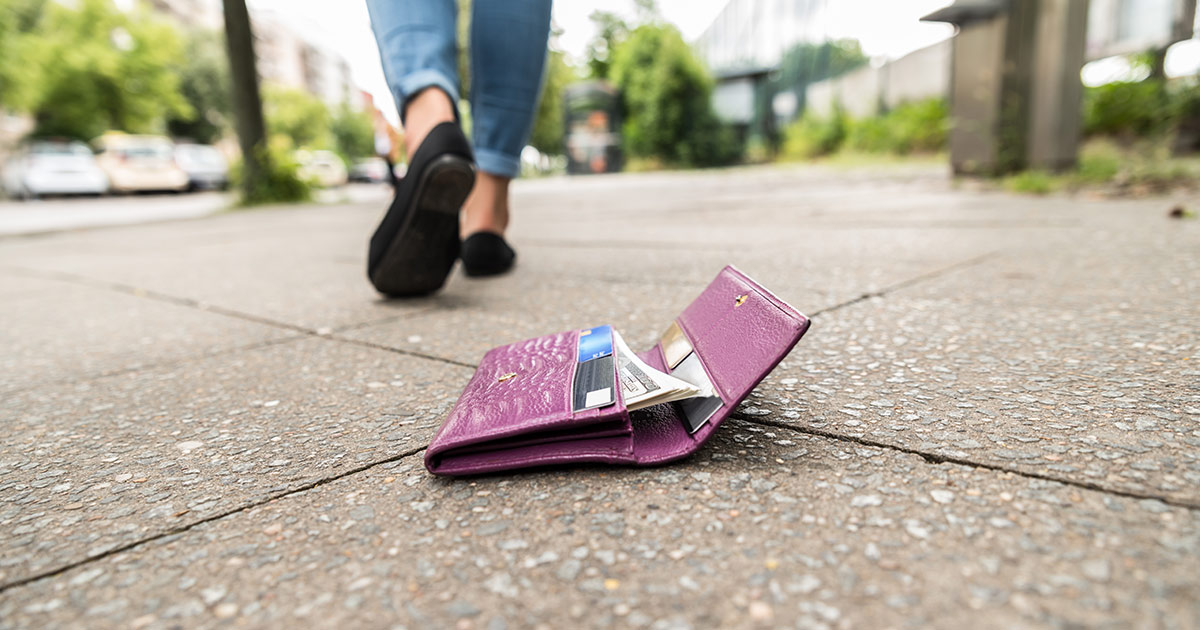
What to do if your wallet is lost or stolen
July 12, 2022
 By Shaniah Ellis
By Shaniah Ellis
Branch Manager
Maybe you drove all the way home before realizing you left your purse on top of the car.
Maybe you made it to the front of the checkout line, only to reach for an empty pocket.
Or maybe you're in a time crunch, and no matter how many steps you retrace, you just can't recall where you left your wallet.
In any case, that moment you realize your wallet is lost — or worse, stolen — isn't just annoying and embarrassing. It can also pose a huge risk to your identity and financial picture. Here are six things you should do right now to prevent identity theft and start getting back to normal:
1) Freeze your accounts
Contact your Bank or financial institution as soon as you realize your wallet is missing. Thanks to the Fair Credit Billing Act (FCBA), you're only liable for up to $50 in fraudulent charges as long as you report your missing debit card within two business days.
Triage the situation and prioritize high-risk accounts: always start with your debit card provider, then call the bank that issues your checks, and finally contact any other credit card companies, including retail stores whose cards you own.
When you report your debit and credit cards as missing, an employee will likely verify and review recent transactions with you to pinpoint if — and when — any fraudulent charges have been placed. Then they'll put a freeze (or hold) on your accounts while they send a replacement card. A freeze isn't the same as cancelling or closing your credit card, so it won’t affect your credit score.
BONUS TIP: Some institutions like Security National Bank offer free card control tools on their mobile banking app. That way, you can freeze your debit card with a single touch (or turn it back on right away, if you happen to find your wallet).
2) File a report
It's important to file a police report if your wallet is lost or stolen. Officers will need a description of your wallet, the items in it and the circumstances surrounding when and where it was lost or stolen.
Most precincts allow you to file police reports online, so you can quickly and easily create a paper trail. Keep a copy of the case number and report for future reference. It might be needed as evidence, or to help your Bank with its own fraud investigation.
The Federal Trade Commission also takes identity theft very seriously, even if they can’t help with immediate recovery. Fill out an additional report at identitytheft.gov to access resources and to document the incident. The FTC regularly publishes studies and analyses with this data to help protect consumers from fraud.
3) Request a Fraud Alert
Placing a fraud alert with one of the nation's three credit bureaus — Experian, Equifax and Transunion — will add an extra verification step if anyone tries to take out a loan in your name.
The three agencies all report to each other, so you only need to request an alert on one credit bureau's website to get coverage on all three. Click one of the links below to request a fraud alert:
Fraud alerts last for one year, and you can extend the protection up to seven years with proof of a police report or FTC identity theft report (see #2 above).
BONUS TIP: While you're there, it might also be a good idea to sign up for credit monitoring services to help identify and prevent future damage. Because of the pandemic, all three credit bureaus are currently offering free credit reporting services.
4) Replace ID cards
Every state has different rules and processes to replace your driver’s license or state-issued ID card. In most cases, you’ll need to brave the DMV lines and request a new card in person. Bring alternate forms of ID, including your social security card, birth certificate, or passport, and tell the clerk that your card was lost or stolen.
Meanwhile, you can get a new health insurance card by placing a phone call to your provider. In most cases, they'll be able to issue a replacement card without changing your plan ID.
If your Social Security card was in your wallet — and remember, it NEVER should have been in the first place — you'll need to notify the Social Security Administration office to get a replacement. It is free, but will take some time to fill out a Form SS-5 (you can get the process started online).
BONUS TIP: Reduce risk by using your wallet less — and paying with your phone more! Features like mobile wallet let you upload your debit card to your mobile device, and pay at checkout with a simple wave or tap of your phone.
5) Change your locks
If the thief has both your keys and your home address, you may also need to change your locks. Stay calm! Most locksmiths provide same-day service, and a home security system can also provide peace of mind if you’re worried about burglaries or the risk of home invasion.
6) Make a list
If you have any patience left after all of those phone calls, it’s time to make a list of anything else you remember having in your purse or wallet:
- Gym memberships
- Student IDs
- Library cards
- Security cards/FOBs (parking ramps, employers, etc.)
This way, you can let the other miscellaneous providers know what happened, prevent additional charges and cast a wider net to potentially catch the thief.
BONUS TIP: If you upload your gift cards, retail rewards or airline miles to an online profile somewhere, you'll have less cards to carry around — and you can always redeem those points before a thief does.
Was this article helpful?
We want to provide solutions that matter, when you need them most. Get the latest fraud and security updates by subscribing to our free newsletter. And if you have any further questions, contact us today.